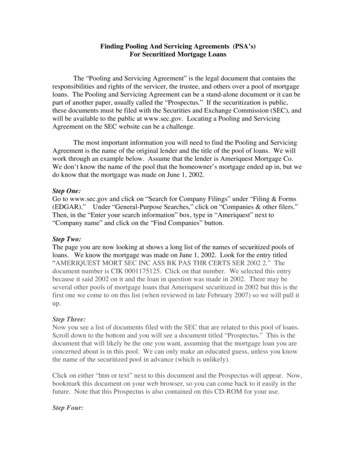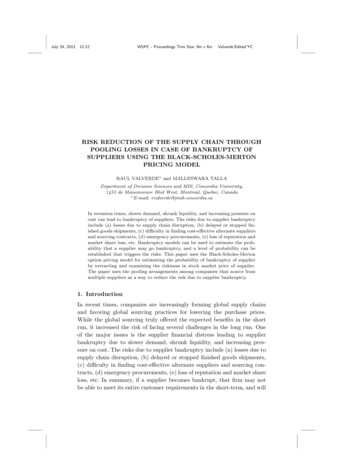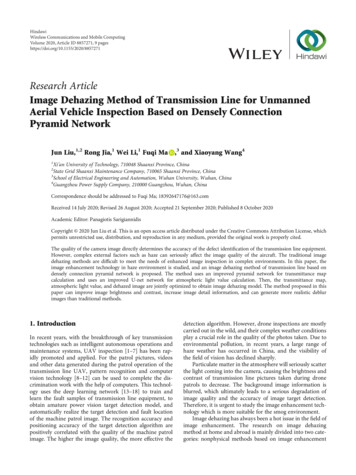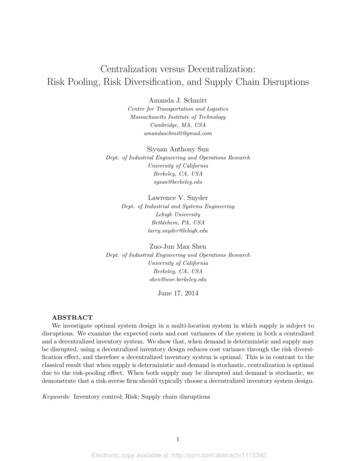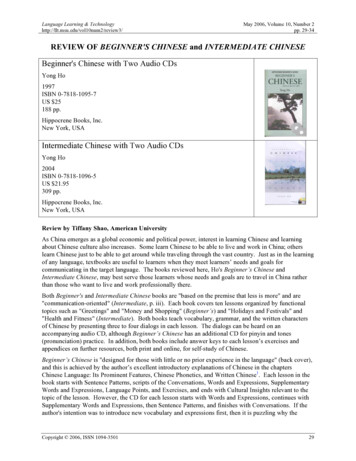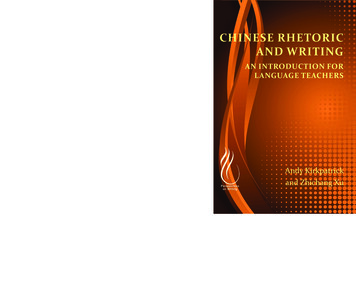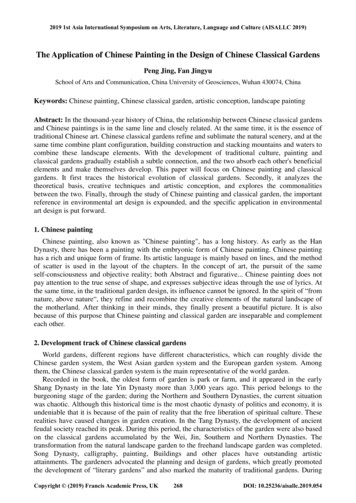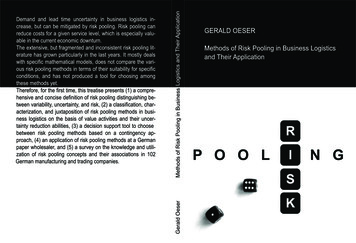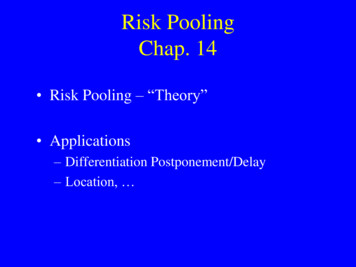
Transcription
Risk PoolingChap. 14 Risk Pooling – “Theory” Applications– Differentiation Postponement/Delay– Location,
HP Case - handed out – preparation questions1. On page 1, it said “We can’t run our business with this level of unproductiveassets.” What are these assets?2. What is “the I-word” referred to?3. Is the ink-jet printer a commodity or fashionable product?4. At the European DC, did HP have too much stock or too little stock?5. What were the symptoms of the problem in the European DC?6. When customers buy ink-jet printers, is brand/product loyalty playing animportant factor in their choosing which products to buy?7. How did the Vancouver Division impress visitors? Was the line suitable for highvolume or low volume production? Why?8. Were Ink-Jet Printers completely built in the Vancouver factory? Can a printerthat was built for the Germany market be directly sold in Italy market? Why? Beprecise.9. What were the performance evaluation criteria for European DC? Should the DCmanager be concerned about the inventory level?10. What were the alternatives for resolving the inventory and service crisis?
Coefficient of VariationCV Standard Dev / Average demandDemand series 1: CV1 0.5Demand series 2: CV2 2.0Which is more volatile?
Risk Pooling Which sales are more volatile: the regionalsales or sales at the store level? Which demand is more volatile : a familyof products or individual members of thefamily? Do people wait longer in a multiplewaiting-lines system than a single-waitingline system? Implication for forecasting ?
Family vs. Individual ProductsSalesNABCTime
Family vs. Individual 20.34Total23,1096,2440.27
Pooling, Profit & Service Level(An Example) Two products (paints) differ only in colour It is fast to mix to the required colour uponreceiving orders Assume that the demand for each follows adistribution given by tossing a dice
An Example Alternative I: Make to Stock Alternative II: Make to Order (for colouringonly) Order-up-to inventory replenishment policy One season, c 2.5, p 12.5, s 0For Alternative I: 5 units for each For Alternative II: ?
Preliminary Calculations12345611,123455,4x4,55,5x4,3xChance of stockout?xx6xxxxxx
Preliminary Calculations12345611,123455,4x4,55,5x4,3xxIf D1 4, D2 5, profit ?;If D1 6, D2 4, profit ?.x6xxxxxx
Holding 10 units of “generic” colour pigment, the chance of stocking out in aperiod is only3/36 1/12 0.083The “risk” of disservice is lowered. Even holding 9 units, a higher level of“service” will be achieved (as compared withAlternative 1)
Preliminary 8910116789101112If D1 4, D2 5, profit ; If D1 6, D2 4, profit 0. IfD1 2, D2 6, profit . Additional cost?
“Theory”T wo products : x1 , x2MeanStdv 1 , 2 1, 2Let x x1 x2 , mean( x ) 1 22Var ( x ) 12 2 1 2 2(a)If 0,(b )If 1,(c )If 1,(d )In general, 1,
Why?
Implications? Variety is the “culprit” of high forecastingerrors, and higher forecasting accuracy can beachieved if only a few varieties are offered Since we can not reduce them, we must find away to get around– By postponing mass customisation– By redesigning the product Universal products and common parts(modules)
Product Variety Proliferation Product proliferation exists in variousforms– global mkt: “protocols”, languages, phases,elec.– local mkt: multiple models differ in features &capacities– mkting strategies Marketing strategy is the major reasonThe world of The Long Tail
Pitfalls of increasing product variety
Risk pooling strategies The objective of a risk pooling strategy is to redesign the supply chain,the production process or the product to either reduce the uncertaintythe firm faces or to hedge uncertainty so that the firm is in a betterposition to mitigate the consequence of uncertainty. Four versions of risking pooling:– product pooling -- delayed differentiation/postponement– location pooling– lead time pooling delayed differentiation (HP case) consolidated distribution– capacity pooling14-18
Postponement Key idea - postpone the commitment ofWIP into a particular finished product –SKU Delay of product differentiation closerto time of sale. Prior to point of postponement, onlycertain degree of aggregate forecastneeded Individual forecasts more accurateclose to time of sale
Postponement Concepts Mainly two forms– Logistics Postponement: moving customisation pointcloser to customers - out of mgr functions– Form Postponement: delaying differentiation point bystandardisation or process re-sequencing
Logistics PostponementManufacturingIntegra- Customi- Locali- PacktionsitiontioningSupply Chain ProcessFactoryDistribution Centers
Logistic Postponement by ProcessResequencing: Paint RetailColour pigments,paint mixing,packagingColour pigments,white paintRetail salesRetail sales,paint mixingpackagingNippon: combined
DishwasherBlackIntegration shipFibDCWhiteBefore module design of themetal frameBlackDC pannel assemblyFab.Integration shipOperationsBufferWhite
Log PP: More Examples Rheem Manufacturing Co., kept 120 SKUs (heaters)at its factory. Some were overstocked while otherfall short - only different in several elements– Using a 3rd party to hold around 10 basic modelsand parts– Filling orders in hours and saving 15% ofinventory cost Even Coffee Rosters use it Of course, PC mfgrs apply it Some done by customers. More real life examples?
PC: indirect model (traditional)PCCompanyOrdersSuppliersMfr :Disk, memory.ProductVARsCustomers
Hybrid ModelPCCompanyOrdersSuppliersFactory: coreDistributionCentersDistributorAssembly ConfigurationProductVARsCustomers
Other examples of delayeddifferentiation Private label soup manufacturer:– Problem: many different private labels (Giant, Kroger, A&P, etc)– Solution: Hold inventory in cans without labels, add label onlywhen demand is realized. Black and Decker:– Sell the same drill to different retailers that want differentpackaging.– Store drills and package only when demand is realized. Nokia:– Customers want different color phones.– Design the product so that color plates can be added quickly andlocally.14-27
Form Postponementby Common PartBeforeAfterSometimes calledstandardization
Mono/Color tomizationColorOperationsNo correlationBuffer
Form Postponementby Process ReengineeringSeries of tests and burn-inPCB InsertionCommontestsCoupon PCBCustomisationtests
Benetton: Process ReengineeringOld SequenceNew SequencePurchase YarnPurchase YarnDye YarnKnit Garment PartsFinish YarnJoin PartsKnit Garment PartsDye GarmentJoin PartsFinish GarmentThis processis postponed
Process Redesign for Supply Chain:Postponement at BenettonDye yarn only after the season’s fashion preferences become moreestablished (knit lead-time much longer than dyeing lead-time).Example: single product; four me: Reduces demand uncertainty & inventory
Demand correlation Correlation refersto how one randomvariable’s outcometends to be relatedto another 8866442200051015200510152020Random demand for two products (x-axisis product 1, y-axis is product 2). Inscenario 1 (upper left graph) thecorrelation is 0, in scenario 2 (upper rightgraph) the correlation is -0.9 and inscenario 3 (the lower graph) thecorrelation is 0.90. In all scenariosdemand is Normally distributed for eachproduct with mean 10 and standarddeviation 3.1816141210864200510152014-33
Limitations of productpooling/universal design A universal design may not provide key functionality to consumers withspecial needs:– High end road bikes need to be light, high end mountain bikes need to bedurable. It is hard to make a single bike that performs equally well in bothsettings. A universal design may be more expensive to produce because additionalfunctionality may require additional components. But a universal design may be less expensive to produce/procure because eachcomponent is needed in a larger volume. A universal design may eliminate brand/price segmentation opportunities:– There may be a need to have different brands (e.g., Lexus vs Toyota) anddifferent prices to cater to different segments.14-34
Summary: When is PPValuable? A lot of varieties Demand uncertainties over the variety are high– Negatively correlated, ?– Positively correlated, ? Differentiation is not too costly to perform locally, ornot time consuming The “core components” have high value, butdifferentiating parts are of low value
Common Obstacles Though often design changes do not cost much, peopleresist their implementation As production cost may increase, prod. people may opposeto changes They also pose challenges to designers Indirect cost savings and intangible benefits
Risk pooling strategies The objective of a risk pooling strategy is to redesign the supply chain, the production process or the product to either reduce the uncertainty the firm faces or to hedge uncertainty so that the firm is in a better position to mitigate the consequence of uncertainty. Four versions of risking pooling:
